 |
Quarters of Madrid

As it is the case in every city, the numerous quarters of Madrid, the Barrios, are what characterizes the Spanish capital. Depending on where one currently is, one will know Madrid from a completely different side as expected. For example, who thought that some of the quarters at the very centre do have a nice village character?
La Puerta del Sol - The Centre of Madrid and of Spain
The Puerta del Sol is the geographical and municipal centre of Madrid. The zero-point is in front of the building of the former headquarters of the post office and is also the zero-point of the whole of Spain, although the actual geographical zero-point is located further to the south. But the Madrileneans do not care about this, as the Puerta del Sol has been officially declared to be the centre. From this plaza, 12 large streets radiate and expand through Madrid and through the whole of the country, as for example the Calle Alcalá.
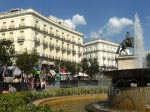
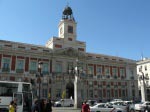
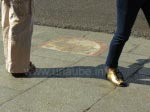
One of the most important streets is the Calle Mayor ("Main Street"), either in former times as also today. It passes the Plaza de la Villa and the former palaces of the nobles, as for example the Palacio del Duque de Abrantes, in which today an Italian Culture Institute is accommodted.
Further streets are the Calle Arenal and the Calle de Tetuan, one of the numerous shopping streets around the Puerta del Sol. In the proximity, there is a small and beautiful baroque church San Ginés of the year 1645, but its arrangement has not much in common with the baroque due to its renovation.
But the zero-ppoint is not the only outstanding element in front of the former hedquarters of the post office: there are also some conmemorative boards that remind on the victims of May 2nd, 1808 and the helpers of the victims who were killed in the terrorist attacks of the year 2004. In the former headquarters of the post office, the regional governance of Madrid is accommodated today. The bell tower of the building sounds 12 times during the turn of the year - a reason for follwing a tradition of the 20th century in which any time the bell sounds, a grape must be eaten.
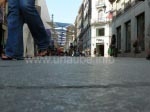
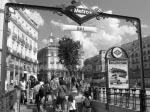
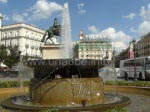

At the Puerta del Sol, the three oldest subway lines of Madrid are crossed: the lines 1, 2 and 3. By observing the plaza of the Puerta del Sol, the large crowds of people are outstnding: tourists, beggars, merchants and Mdrileneans during their shopping. Although the Puerta del Sol is barried for cars, there are always vehicles visible: taxis, buses and tourist buses.
But the the Puerta del Sol is most of the times a trespassing area and meeting point as also a strting point for going ut at nights. A specially popular meeting point is the emblem El Oso y el Madroņo, the bear, that is eating some strawberries from the strawberry tree. The monument was supposed to demonstrate the union between the nobility and the clergy.
According to my opinion, the Tío-Pepe-advertisement does not match at all to the whole of the picture and specially not at nights, as it forms a contrast to the nicely illuminted fountain and the rest of the buildings. But it has one advantage: one can quickly get orientated by it, specially at nights.
The surrounding of the Royal Palace - Following the Traces of the Habsburgs and Bourbons
Many times seeked by the tourists as first or second destination, a view to the surroundings of the Royal Palace and Opera (subway lines 2 and 5)is worthwhile despite of the crowds of people. As already suggested by the title, it is a quarter of the upper class and a visit confirms this: the meticulously maintained gardens Sabatini, the Teatro Real (Royal Theater), the Plaza de Oriente and of course the Palacio Real are only some of the witnesses of the royal history. More sightseeings of this quarter are surely the hidden and beautiful garden complex Campo del Moro and the Catedral Nuestra Seņora De La Almudena, that was not finished until the end of the eighties. Located in the same street as the Palacio Real and the Cathedral, there is the Basílica de San Francisco El Grande, a church full of paintings and arts of Goya, Zurbarán and others.
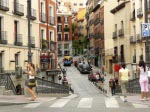
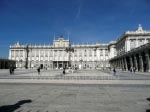
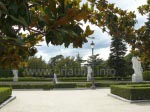
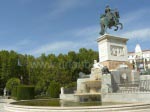
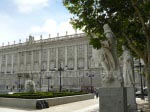
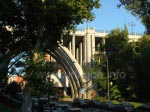

In the proximity, there are also some smaller godhouses as the churches Santiago, San Nicolás - and specially bautiful: the church San Miguel. In the proximity of the palace there is moreover the convent Monasterio de la Encarnación that is worthwhile to visit in any case.
Another interesting building is the Viaducto tht communicates the royal palace ans the Basílica de San Francisco El Grande with each other. As actually, the Calle de Segovia is located in a deep fosse in between. In the Jardines de las Vistillas at the street Calle lo Ciegos, one has a beautiful view to the Sierra de Guadarrama and to the cathedral, a thing tht is specially beautiful during the sunset. From there, one can descend the wide stairs to the Calle de Segovia and admire the illuminated Viaducto at night.
La Latina - que chulo!
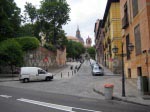
La Latina - what do think the Madrileneans about it? "Que chulo, que guay!" will most of them say, things that mean something as "How cool, excellent!". If one walks through the former moorish quarters named after the same named subway station, one will, depending on where one currently is, think about why the Madrileneans are so enthusiastic about La Latina. Some streets look a little deteriorated, some streets seem to be very common without any specialities; When I moved into this quarter, I started to discover the speciality of this quarter: although La Latina is located amidst the centre, is has kept a village character with all its small streets - specially in the mornings: at 7.30 a.m. it is (except the main road Calle de Toledo) still so quiet that one really thinks to be in a Spanish village and not in the narow centre of the Spanish capital.
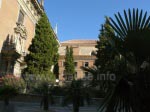
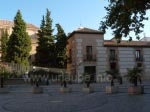
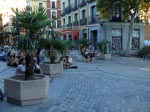
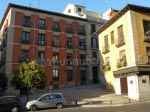
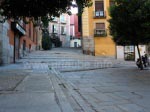
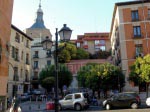
The major part of the quarter has been restored; nevertheless, one historical area has been kept in La Latina that is the surrounding of the Plaza San Andrés. The Plaza San Andrés is one of the most beautiful plazas of Madrid and in any case it is a must to visit it. The historical plaza is popular among old and young people, for having a walk or just to exchange the news. Many people simply like to be on the plaza with some beverages.
The abundant bars around the Plaza San Andrés and in the romantic alleyways around the Calle de Segovia are characteristical - an important criterion for the Madrileneans. Once, a colloeague even told me that in La Latina there is a restaurant where one could lay comfortably in a bed while dining. But I never visited this restaurant; I prefer to eat at a table.
Huertas - In former times, the Quarter of the Poets and Dramatists
Today, it is the city of the clubs, taverns, bars and pubs - a typical area for going out. In the evenings and at nights, the Plaza Santa Ana that is located close to the Puerta del Sol (subway Sol, L1, L2, L3) is crowded with people. In the streets arund the plaza, young people go from one club to the other, others get refreshed with a tapa before continuing.
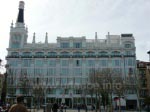
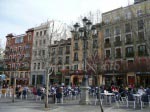
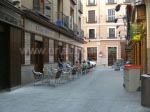
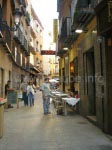
How comes such a change happened? Many people might Maybe it is due to the narrow and labyrinthine streets full of flair that attract the Madrileneans and the visitors so that so many clubs and bars established there. Also the proximity to the centre is a probable reason for this developement of the quarter that is named after a street named Huertas which means in english "vegetable garden".
During the day, sometimes Huertas ppears very lively, but sometimes very quiet, so quiet that the wild nightlife that takes plce here is hard to imagine. In Huertas, the three littérateurs Miguel de Cervantes, Luis Góngora, Francisco Quevedo and Felix de Lope Vega are supposed to have spent some time and worked here. Thus, in order to honour Lope Vega, his former residence was rearranged to a small museum. From time to time, some citation are readable in golden letters that adorn the Calle de las Huertas.
Cinemas, Theatre, Shoppingmile: The Gran Vía
Those who - after having seen a lot o historical sightseeings - are looking for different side of Madrid thst is the one of the pulsating metropolis - should go to the Gran Vía. It is one of the most importnt streets of Mdrid and communicated the die Plaza de Espaņa with the Calle Alcalá that is initiated in the Puerta del Sol and that leads, amongst others, to the traffic junction Plaza de Cibeles.
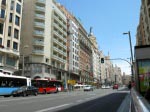
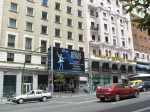
But the Gran Vía is not only characterized by the noisy traffic - no, one rather associates the Gran Vía with its big city flair with its cinemas, theatres, musicals, banks, shops and shopping centres.
The Gran Vía was not finished until 20 years after the beginning of its building in the year 1910, thus relatively late. The plans for the boulevard already existed long time before; the problem was the realization. 14 streets and approximatel. Those who only want to have a view to the Gran Vía get the possibility for this by getting out at the subway sttions Banco de Espaņa (L2), Gran Vía (L1, L5), Callao (L3, L5), Santo Domingo (L2) or Plaza de Espaņa (L6, L10.As a final point, specially the visit of the Plaza de Espaņa and the closely located Templo de Debod, an ancient Egypt and worthwhile seeing temple in Madrid, are a good option.
Chueca - Madrid Gay
I leave the subway exit "Chueca" of the line 5 that has the same name as the quarter I will go to now. I have to admit that I am really curious abut how a Madrilenean quarter that is famous for homosexuality looks like. Is it going to be a "very normal" Barrio from the exterior or will one immediately feel as being in a different world?
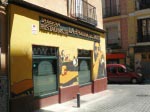
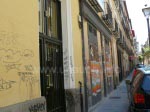
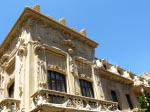
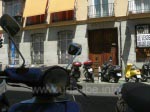
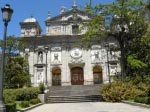
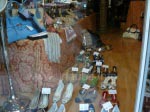
If one wouldn't knew anything about it and just shortly walks through the quarter during the daytime, one would see the cafés and bars - as everywhere in Madrid - as also the small shops around the plaza that surrounds the subway station. The partly deteriorated portals and huse walls are outstanding, as they are wildly graffitied and are a big contrast to the restored and expensive looking appartment blocks; A contradiction? Only at first sight. I am informed about the fact that once, Chueca was a problematic quarter with a high criminality. At the beginning of the ninetees, the homosexuals came to the quarter who provided a significant boom to it. Slowly, many areas of Chueca were restored, fashion shops were opened - in Chueca, there are now some of the most expensive designers of Madrid located - and the criminality disappeared. After some time, those shops were opened that were focused to the "Gays" and "Lesbianas", as for example libraries with the respective books.
Each year in June, there is an event in Chueca that is similar to the Christopher-Street-Day - during a whole week-end. The festival seems to be very famous: the streets are so crowded that it is hard to leave the subway exit and there are even tourist coming to Madrid specially for this event.
And how is the rest of the impression of Chueca? Chueca reminds a little on Italy, where there are as many Vespas to see. During the summer time, the streets are quite deserted during the noon timeand the churches Salesas Reales at the same-named plaza and the church San Anton in the Calle Hortaleza are, as the other churches, closed during this time. The church San Anton has, by the way, a very curious habit: Each year on January 17th, the pets are blessed at the entrance of the church so that they also have an eternal life after their death.
Malasaņa - a piece of Madrilenean History
A restored quarter with small shops, coffee bars and bars, a preferred quarter for going out for the young people and a quarter with an important peace of history - this is Malasaņa. The former quarter of the craftsmen still appears a little as a village and much more Spanish than some other areas, as for example the Gran Vía. The majority of the people seem to be local people and everyone seems to know everyone.
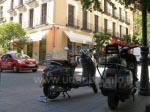
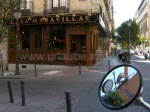
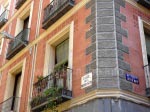
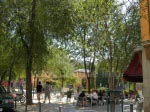
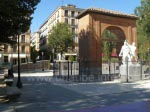
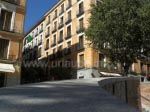
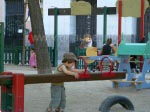
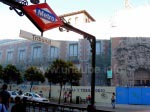
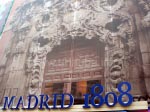
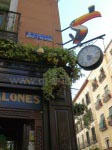
The Plaza del Dos de Mayo is the centre of the quarter Malasaņa. There, young people enjoy the sun, smoke and listen to music while the parents observe their chuildren in the playgrounds. The quarter is one of the few places in the proximity of the centre where the boys can play football and ride a bike without being disturbed. By looking to the plaza, the less people can imagine that once, the Palace of the Duques of Monteleón stood here up to the year 1723. But it was destroyed by a fire to such an extent that only the Puerta de Monteleón survived the fire. The Puerta de Monteleón can be still viewed today and as the monument Antonio Solá, it indicated to May 2nd, which name has the Plaza del Dos de Mayo.
The name of the Plaza del Dos de Mayo reflects one of the most important events of the city history of Madrid: the strong fight against the French on May 2nd, 1808, who marched in under the guidance of Napoleon. The superiority of the French cost the life of many Spaniards; the death of a young 15-year-old girl remaind the longest time in the people's minds. The young Manuela Malasaņa helped her father with all her energy but she was hurt and bleeded to deth. The quarter is named after her, the original name was "Barrio de Maravillas". Also in the surrounding streets, the young female heroe is present; the names of streets, chemistries, bars and cofee bars remind on her. In former times avoided as a quarter of junkies, today, Malasaņa is a popular quarter for going out that specially attracts young people.
During the visit of the quarter Malasaņa one has the opportunity to shortly visit the Museo Municipal right at the subway station Tribunal (L1, L10). Since the year 1929, the city museum is opened that shows paintings, photographies and documents about the city developement and the history of Madrid. Thereby, the invasion of Napoleon and May 2nd play the main role. Moreover, the developement of the municipal surroundings as the Puerta del Sol is very interesting, that is shown from different perspectives. What is specially nice of the Museo Municipal is the arrangement of the building. The baroque entrance is gorgeosly built; the interior is dominated by the distinguished colours light beige and dark blue.

Back to the index Madrid
Author: Stefanie Kotulla; Copyright 2008-2008: Patrick Wagner, www.tourist-guide.biz
|
 |